Recommended Books
The external publications listed here contain materials that are relevant to all experience levels of asset management professionals. Please note that, while recommended, the publications listed may not reflect the views of the Institute.
Risk, Opportunity and Performance - The Art of Taking Worthwhile Risks
By Clive Deadman
Published June 2025
Risk, Opportunity, and Performance explores the realm of strategic risk-taking from psychological, personal, and business perspectives, tracing 8,000 years of human evolution to the present day.

To drive growth and performance, regulators, board members, local leaders, and front-line staff must decide their level of ambition, manage risks, and learn from acceptable losses. Coordinated and controlled risk-based systems, processes, and organisational cultures are essential for this. The approaches used by high growth enterprises, banks, property and infrastructure, manufacturing, pharmaceuticals, medicine and fraudsters can be very different. We explore why this is so and how different industries can learn from other sectors.
Through extensive research and inspiring and sometimes tragic case studies the book examines how visionary leaders have used modern risk management systems and emotionally intelligent leadership styles to succeed in an increasingly risk-averse environment. With the rise of modern information systems, artificial intelligence and machine learning it explores how risks can be better managed, allowing us to focus more on identifying and seizing opportunities.
Legacy: A Decision Maker's Guide to Infrastructure
By Ruth Wallsgrove and Lou Cripps
Published May 2025
Legacy: A Decision-Maker’s Guide to Infrastructure is not another technical manual. It’s a clear-eyed, call to rethink how we lead and make decisions about the physical assets that shape our daily lives - from water systems and roads to hospitals, parks, and transit networks.
Written by respected infrastructure thinkers, Ruth Wallsgrove and Lou Cripps, Legacy distills decades of frontline experience into practical guidance for those who carry the weight of stewardship. This isn’t about technology or buzzwords. It’s about responsibility. Clarity. Purpose. And asking better questions.

What kind of legacy are you leaving behind?
If you're responsible for public infrastructure—whether you're on a board, or in the C-suite - this book is an essential companion.
Legacy: A Decision-Maker’s Guide to Infrastructure is not another technical manual. It’s a clear-eyed, call to rethink how we lead and make decisions about the physical assets that shape our daily lives - from water systems and roads to hospitals, parks, and transit networks.
Written by respected infrastructure thinkers, Ruth Wallsgrove and Lou Cripps, Legacy distills decades of frontline experience into practical guidance for those who carry the weight of stewardship. This isn’t about technology or buzzwords. It’s about responsibility. Clarity. Purpose. And asking better questions.
By Martin Kerr
Published March 2025
The disciplines of change management and asset management are interchangeable. Asset management seeks to deliver and sustain value as it is achieved (realized), and change management is how we get to the destination of sustained value.
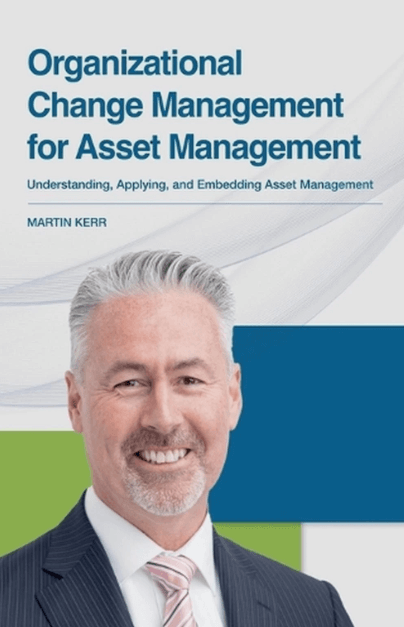
The disciplines of change management and asset management are interchangeable. Asset management seeks to deliver and sustain value as it is achieved (realized), and change management is how we get to the destination of sustained value.
I want to share my experiences and insights into what hasn't worked right through to what has worked. My purpose here is to transfer that knowledge to you to enable you to make informed decisions and understand change management as a core capability of an organization, but also acknowledge that every organization on earth is already undertaking asset management. For that part, this book is intended to give you an advantage in the marketplace and help your organization succeed in delivering value to stakeholders.
The Story of Asset Management: Infrastructure. We can afford to buy it. Can we afford to keep it?
By Dr Penny Burns
Published October 2023
The Story of Asset Management’, by Dr. Penny Burns, offers a detailed and lively account of the gradual emergence of asset management practices, spanning a decade of development.

While discussions about government reforms often take center stage, the behind-the-scenes processes of problem-solving and innovation remain less documented. In this book, readers are provided a unique opportunity to witness the challenges, successes, and setbacks faced by trailblazers in the field of asset management from its beginnings in Australia in 1984 and onward, enriched by engaging anecdotes that highlight the era.
Join this journey into the past and gain a deeper understanding of the foundation on which contemporary asset management principles are built.
THE AUTHOR: Dr Penny Burns found herself uniquely positioned at the intersection of economics and engineering in 1982. Building on her foundation in experimental economics, she embarked on reshaping the field, and has captured those early years in this engrossing story. Another of her notable contributions was the establishment of the Strategic Asset Management newsletter in 1994, a publication that evolved into a vital resource for policy and practice, and Talking Infrastructure in 2016.
Building an Asset Management Team
By Lou Cripps and Ruth Wallsgrove
Published April 2020
Building an Asset Management Team is a practical and lively guide for anyone who needs to do infrastructure Asset Management. It tackles who you need and why you need them.

Asset Management is increasingly important, legally mandated in many countries. ISO 55000 defines AM as the ‘coordinated’ activities of an organization to realize value from its assets. But longer term co-ordinated asset plans and strategies take real effort and skills. You can’t just think things better.
To succeed, you require good business understanding, broad technical knowledge of the assets, analytical skills, and great facilitation & communication…. Instead of searching for a platypus, it’s easier to build a complementary team.
Invaluable if you are developing a business case for setting up an AM team, considering where to locate the team in your structure, or how to attract and keep the right staff.
Proceeds go to www.talkinginfrastructure.com
Asset Management: Transforming asset dependent businesses, second edition
Edited by Chris LLoyd and Michael Corcoran
Published July 2019
With contributions from leading advisers, industry experts and academic researchers, Asset Management, Second edition is an essential reference on the practicalities of adopting asset management principles, methods and techniques. The book demonstrates how asset management can transform the prospects of infrastructure and asset dependent businesses, by reducing risks and costs, and generating increased value for shareholders and stakeholders.
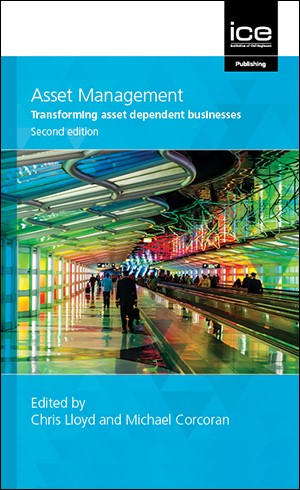
Asset Management: Transforming asset dependent businesses, Second edition
Edited by Chris Lloyd and Michael Corcoran
Published July 2019
With contributions from leading advisers, industry experts, and academic researchers: Asset Management, the Second edition is an essential reference on the practicalities of adopting asset management principles, methods, and techniques. The book demonstrates how asset management can transform the prospects of infrastructure and asset-dependent businesses, by reducing risks and costs, and generating increased value for shareholders and stakeholders.
Asset Management Insights Phases, Practices and Value
By Celso de Azevendo
Published April 2019
Uniquely organized, Asset Management Insights follows the life cycle of industrial assets and infrastructures. Indeed, one of the fundamental points of the definition of asset management is its management perspective covering the entire life cycle of assets rather than specific segments such as maintenance. This new book reviews the thematic components of asset management both from a conceptual point of view (originality, approaches, methods, tools) and from the point of view of its practical application (conditions to be met, recurrent difficulties, and organizational constraints).
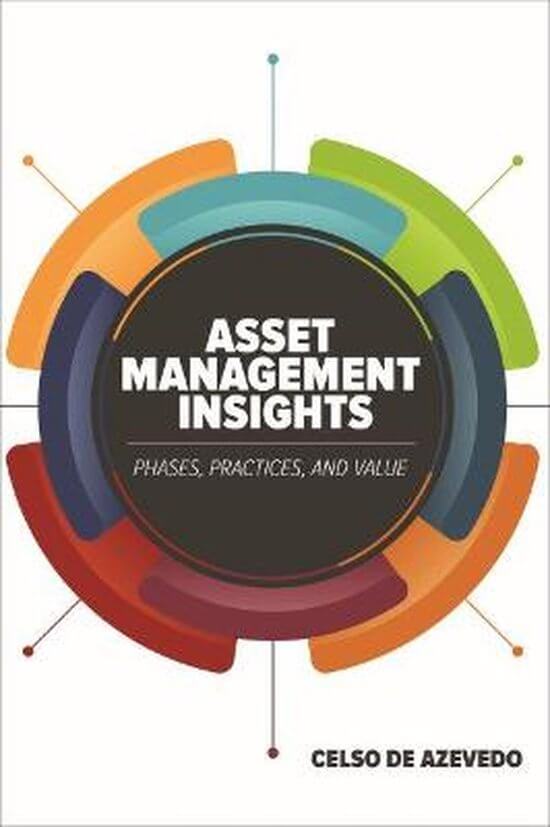
Celso de Azevedo has a reputation in the field of Asset Management which always precedes him. I had the privilege of meeting Celso for the first time at the inaugural meeting of ISO/PC251 (Asset Management) in Melbourne, Australia in 2010. When I met him, and engaged with him, I quickly learned that everything about his reputation was true. A man with a heritage spanning Brazil and France bringing the passion we expect from those cultures to all things Asset Management in a larger than life way but merged with a vast experience and ability to analyze and learn.
In our ongoing work on Asset Management in ISO/TC251 (we changed from a Project Committee to a Technical Committee with a wider scope in 2015) our focus is on helping organizations deliver “value.” For many people, the word “value” is interpreted as a financial value only, but we live in a complex world with complex stakeholder groups, each with competing demands and competing definitions of what “value” means to them. That value may be financial, but it may also be safety, or environmental or ambience or reliability or a myriad of other tangible and intangible benefits depending upon the respective viewpoints of those stakeholder groups. Pleasingly, the core of this book is “value” and how it is overlaid across the asset life cycles and how it relates to costs.
This is a nice approach because in our organizational worlds, we may only have a single window through which to view one part of the asset life cycle, so for all readers there will be at least one section of the book with which they are familiar. The remainder of the sections are areas with which they should be familiar,
and this is the Asset Management paradigm. Namely, we must have an understanding of all life cycle phases and all organizational functions even when our own function and window on a specific life cycle phase may be dominating our daily thoughts. If this is not complex enough, Asset Management is a young discipline with many evangelists claiming to know the one true way! This leaves any author with a dilemma on how to balance the need to communicate a new discipline in an authoritative way to those who want to learn, while at the same time, hypothesizing and exploring how the discipline will grow. All of this needs to be achieved without appearing to shout from an ivory tower. No simple task at all!
Celso has written this book in a way that enables us to explore Asset Management thinking throughout the life cycle of the assets but with a focus on value (both tangible and intangible), recognizing the importance of cost and how we express intangible value through the measurement of monetized risk. He does not claim to have that singular truth of how to solve all Asset Management problems but instead presents his perspective on those problems through his extensive experience both from infrastructure and industrial scenarios around the globe. He presents theories for solutions, not in a mandatory way, but more in the approach of the traditional scientific method. By this I mean that this book is an invitation to challenge and test his theory through our own experience and application. This addresses, I believe, the problem of the evangelist author and his singular truth.
What of the problem of writing about complex organizations and complex asset life cycles? Inevitably in writing a sequential book it is required that the text be divided into chapters. Some readers will be drawn to individual sections to learn or even to challenge. Others will read the whole book from front to back. I am sure Celso would invite us to learn and become expert in each of the areas explored but having known him for many years, I am also sure that he would advocate total adoption of all of the thinking to some extent. For me, this reflects the complex nature of Asset Management, where we need a broad view of context and the ability to apply analytical approaches in great detail into that broad context.
In another potential life where Celso de Azevedo was perhaps Dutch and not Brazilian/French, he may have termed it Total Asset Management like the great Dutch soccer teams of the 1970’s. In Total Football, a player who moves out of his position is replaced by another from his team, thus retaining the team’s intended organizational purpose and approach. I feel there is much of this book that reflects this thinking and I hope that you: enjoy it, learn from it, test it and challenge it to deliver greater value for your organization’s stakeholders.
Rhys Davies
Chair of ISO/TC251—Asset Management
How Management of Public Assets Can Boost or Bust Economic Growth
Authors: Dag Detter & Stefan Fölster
Published 2015
We have spent the last three decades engaged in a pointless and irrelevant debate about the relative merits of privatization or nationalization. We have been arguing about the wrong thing while sitting on a goldmine of assets.
Don’t worry about who owns those assets, worry about whether they are managed effectively. Why does this matter? Because despite the Thatcher/ Reagan economic revolution, the largest pool of wealth in the world – a global total that is much larger than the world’s total pensions savings...
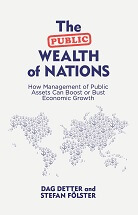
We have spent the last three decades engaged in a pointless and irrelevant debate about the relative merits of privatization or nationalization. We have been arguing about the wrong thing while sitting on a goldmine of assets.
Don’t worry about who owns those assets, worry about whether they are managed effectively.
Why does this matter? Because despite the Thatcher/ Reagan economic revolution, the largest pool of wealth in the world – a global total that is much larger than the world’s total pensions savings, and ten times the total of all the sovereign wealth funds on the planet – is still comprised of commercial assets that are held in public ownership. If professionally managed, they could generate an annual yield of 2.7 trillion dollars, more than current global spending on infrastructure: transport, power, water, and communications.
Based on both economic research and hands-on experience from many countries, the authors argue that publicly owned commercial assets need to be taken out of the direct and distorting control of politicians and placed under professional management in a ‘National Wealth Fund’ or its local government equivalent. Such a move would trigger much-needed structural reforms in national economies, thus resurrect strained government finances, bolster ailing economic growth, and improve the fabric of democratic institutions.
This radical, reforming book was named one of the "Books of the Year".by both the FT and The Economist.
Asset management decision-making: THE SALVO PROCESS
Edited by John Woodhouse
Published by the Woodhouse Partnership, 2014
This guidebook explains what it takes to make the right decisions in the management of assets. It covers not just the steps and disciplines required, but also how to create a clear ‘business case’ to justify and communicate the outcomes, so that everyone can agree on what is worth doing, when and why.
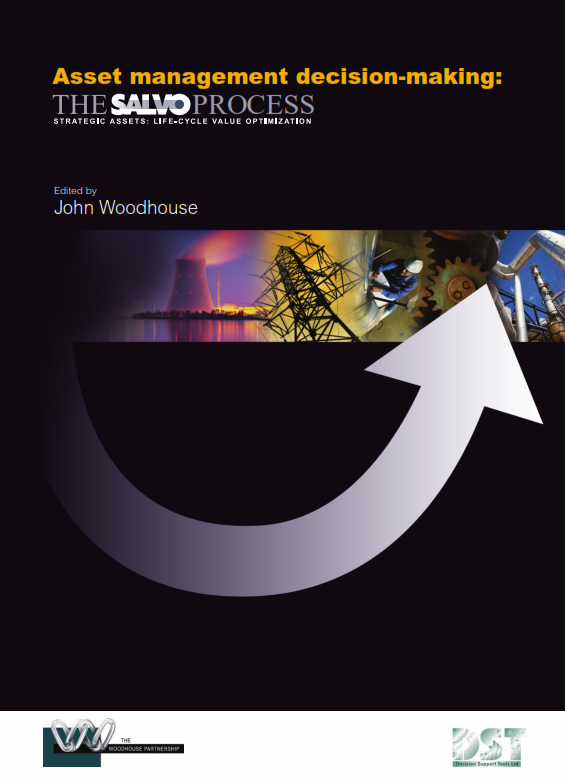
About the author
John Woodhouse is a widely known expert in integrated asset management. He is a Founder, Fellow and Chair of the Panel of Experts for the Institute of Asset Management. He Chaired the BSI/IAM development of the PAS 55 standard for optimal management of physical assets, and was UK Expert Representative in the development of the first International Standard for Asset Management (ISO 55000).
He has also led the development of the first published Competences Framework (IAM 2006), and was Programme Director for the European MACRO Project (EU1488) and International SALVO consortium, researching and developing best practices in asset management decision-making and in optimization of life cycle value.
John is CEO of the consulting and training organisation, TWPL, providing advice and competency development to most industry sectors in over 25 countries. With a personal background as a senior manager in the oil industry and engineering, he launched TWPL in 1995 with a group of former senior industrial managers from nuclear, oil, utilities, defence and manufacturing sectors. 20 years on TWPL is one of the most experienced international sources of pragmatic advice and implementation support to organisations wishing to improve their asset management.
John holds a Masters degree from the University of Cambridge, where he was also captain of the varsity Boat Race crew. He has also skippered a round-the-world sailing yacht and is author of the book 'Managing Industrial Risk' (Publ. Chapman & Hall, 1993). He now lectures widely around the world at conferences and through university and in-house management training programmes.
Reviews
"The SALVO Project has helped us to identify and demonstrate the optimal timing of asset replacements and the optimal frequency for maintenance interventions. The outputs from SALVO are key components of our ‘Asset Master Plans’: we are now in the best place we have ever been."
Geoff Aitkenhead, Asset Management Director, Scottish Water.
"Our clients really need processes like SALVO – which provides a consistent, structured and quantified means of evaluating what to spend on their facilities, when and why."
Keith Hamer, Group VP Engineering & Asset Management, Sodexo
International Case Studies in Asset Management
Edited by Chris Lloyd
Published by ICE Publishing, 2012
This publication shows companies and interested parties at all levels how asset management can be used to provide organisations with the strategic perspective, transparency and tools required to make best use of budgets, maximise returns on capital and grow market value.
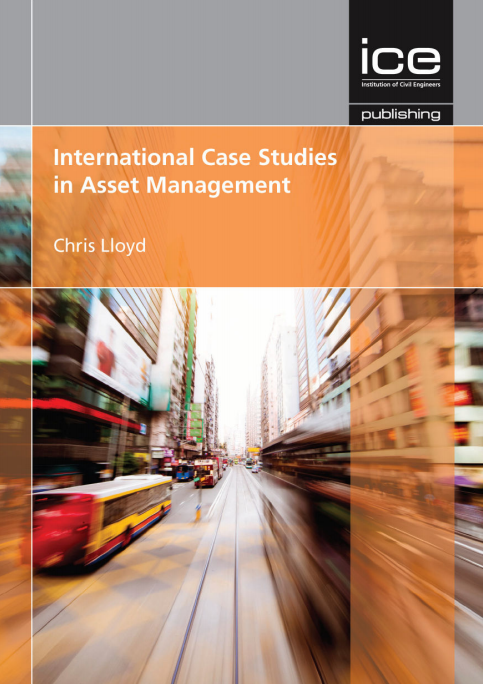
Publisher's Description
International Case Studies In Asset Management shows companies and interested parties at all levels how asset management can be used to provide organisations with the strategic perspective, transparency and tools required to make best use of budgets, maximise returns on capital and grow market value.
The case studies in this book offer a wealth of knowledge and experience of how to embed asset management thinking and use it to improve service, reduce risk and become more competitive. With a strong emphasis on leadership, the book shows readers how they can change the way people work, break down boundaries and create cultures that support asset management.
Internationally applicable and relevant across sectors, the book includes seventeen case studies from seven countries featuring local, national and global organisations operating in water, railways, metros, mining, ports, energy and municipal services. It is a key reference for anyone involved in asset management - whether new to the subject, studying for a qualification, developing an asset management system, strategy, or regulatory framework, or appraising infrastructure investment opportunities. This book is best read as a companion to Chris Lloyd's earlier book, Asset Management: Whole Life Management of Physical Assets (Thomas Telford, London, 2010).
Reviews
“ An essential collection of hard earned lessons, insights and good practice examples.”
Stephen Morris, President, Institute of Asset Management
“These case studies demonstrate that the journey from theory to practice has well and truly begun in the field of asset management and highlight that effective leadership, appropriate commercial focus and cultural change are our tools for success.”
Anthony Vaughan, Senior Vice President, Brookfield Infrastructure Group
Strategic Asset Management: The Quest For Utility Excellence
Written by Clive Deadman
Published by Troubador Publishing, March 2010
One of the first books ever written specifically on the strategic management of utility industries, this publication is especially relevant to water, gas and electricity asset management.
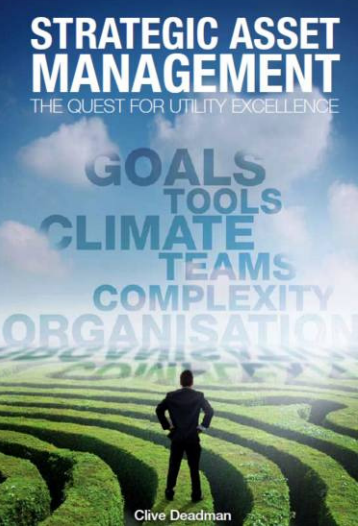
Publisher's Description
One of the first books ever written specifically on the strategic management of utility industries will be previewed in London on March 4th, at the prestigious Utility Regulation 2010 Seminar, hosted by SGBI and attended by regulators and senior figures from the water, gas and electricity industries.
Entitled Strategic Asset Management: The Quest For Utility Excellence, the book is sponsored and recommended by the Institute of Asset Management (IAM) as essential reading for regulatory authorities, as well directors and managers at all levels in utility companies.
The book answers the key question of how utilities can select the right goals, organisational design, culture and engineering tools, which allow them to manage their complex asset bases and deliver truly excellent performance. With 37 case studies and 50 diagrams, it illustrates the snakes and ladders that leading utilities have experienced on the path to excellence.
About the author
Clive has lived and worked in the UK and France, studied chemistry at Cambridge University and worked in the African mining industry. On returning to Europe he joined the venture capital arena and invested in and became a Director in a range of engineering businesses.
On joining the utility sector, he developed a strong desire to understand the value that utilities receive operating and investing in their regulated assets. Over the last 15 years, he has introduced several groundbreaking asset management initiatives to United Utilities businesses, in the UK and internationally. He is a council member of the Institute of Asset Management and chairman of the Energy Innovation Centre’s Investment Forum.
Reviews
"This is a book every utility asset manager and utility leader needs to read."
Robert Davis, Institute of Asset Management
“This is a practical book which draws on my personal experience of running utility businesses, together with the cumulative wisdom of leaders of utilities, who own and operate over £750 billion of electricity, water, wastewater, gas, rail and power generation utility assets and provide services to 300 million customers.”
Clive Deadman, Author
Asset management - Whole-life management of physical assets
Edited by Chris Lloyd
Published by Thomas Telford, London, February 2010
This book offers comprehensive and accessible coverage to all major aspects of asset management, acting as an invaluable reference for those working in or learning about asset-intensive industries.
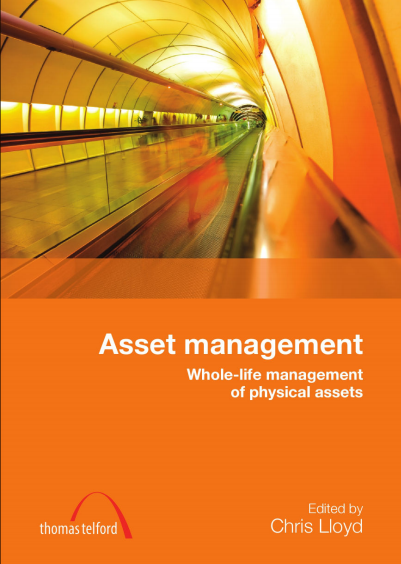
Publisher's Description
The first book of its kind, Asset Management offers comprehensive and accessible coverage of all major aspects of the subject, providing an invaluable reference to those working in or learning about asset-intensive industries.
Bringing together the insights, experience and advice of a panel of leading thinkers and practitioners, Asset Management gives readers multiple perspectives on the practicalities of adopting asset management principles and equips them with the tools and frameworks they can use to create effective asset management strategies and cultures within their organisations.
Contributors draw on data, case studies, examples and illustrations from a wide range of sources from the rail and utilities sectors, to public sector management and major civil engineering works.
Key features:
Rapid entry to asset management thinking and best practices.
An all-round perspective on asset management applicable to all sectors.
Advice and guidance on the practicalities of adopting and implementing asset management principles.
A collection of planning and analysis templates, maturity scales, process diagrams, outline strategies, hints and tips and extensive references to further reading.
Concise, authoritative summations of experience to date.
About the editor
Chris Lloyd is Managing Director of CAS, a psychology based consultancy which advises clients on asset management competence and culture. He is a member of the Council of the Institute of Asset Management, Chair of its Qualifications and Professional Development Committee and oversaw the development of the IAM Competences Framework which was published in 2008.
Reviews
“Each chapter moves effortlessly between the theoretical and the practical and is littered with real life examples of both good and bad asset management practice”
Robert Davis, Institute of Asset Management
“Asset Management is changing the way businesses are thinking – this book will help people put that thinking into practice”
Chris Murray, National Grid, plc

